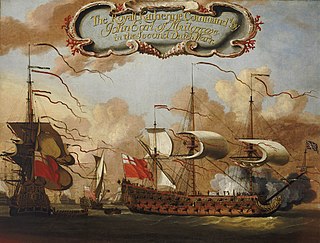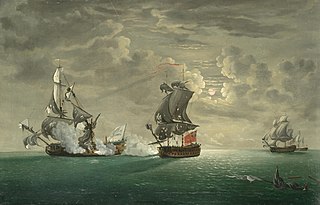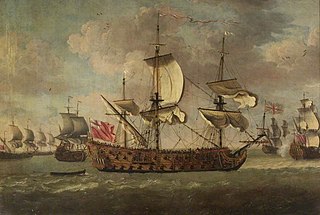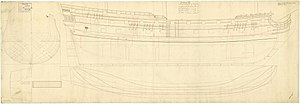HMS Ocean was a 98-gun second-rate ship of the line of the Royal Navy, launched from Woolwich Dockyard on 24 October 1805. She was the only ship built to her draught, and designed by Sir John Henslow.

HMS Royal Katherine was an 84-gun full-rigged second-rate ship of the line of the Royal Navy, launched in 1664 at Woolwich Dockyard. Her launching was conducted by Charles II and attended by Samuel Pepys. Royal Katherine fought in both the Second and Third Anglo-Dutch Wars and afterwards, the War of the Grand Alliance before entering the dockyard at Portsmouth for rebuilding in 1702. In this rebuilding, she was upgraded to carry more guns, 90 in total, and served in the War of the Spanish Succession during which she was renamed Ramillies in honour of John Churchill's victory at the Battle of Ramillies. She was rebuilt again in 1742–3 before serving as the flagship of the ill-fated Admiral John Byng in the Seven Years' War. Ramillies was wrecked at Bolt Tail near Hope Cove on 15 February 1760.

HMS Monmouth was a 66-gun third-rate ship of the line of the Royal Navy, and was likely named for James, Duke of Monmouth. She served from 1667 to 1767, winning ten battle honours over a century of active service. She was rebuilt a total of three times during her career—each time effectively becoming a completely new ship.

HMS Medway was a 74-gun third rate ship of the line of the Royal Navy, launched on 19 November 1812 at Northfleet.

HMS Falkland was a 50-gun fourth-rate ship of the line of the Royal Navy, built by Holland of New Castle, New Hampshire, and purchased by the navy in 1696.

HMS Swiftsure was a 70-gun third-rate ship of the line of the Royal Navy, built by Sir Anthony Deane at Harwich, and launched in 1673. By 1685 she had been reduced to a 66-gun ship.

President was a 38-gun fourth rate frigate of the Royal Navy, originally built for the navy of the Commonwealth of England by Peter Pett I at Deptford Dockyard, and launched in 1650.

Dunbar was a 64-gun second rate ship of the line of the English Royal Navy, originally built for the navy of the Commonwealth of England at Deptford, and launched in 1656. Renamed HMS Henry in 1660, she served until 1682, when she was lost in an accidental fire.

HMS Medway was a 60-gun fourth rate ship of the line of the Royal Navy, launched at Sheerness Dockyard on 20 September 1693.

HMS Windsor was a 60-gun fourth rate ship of the line of the Royal Navy, launched at Deptford on 31 October 1695.

HMS Mary was a 60-gun fourth rate ship of the line of the Royal Navy, built at Chatham Dockyard and launched on 12 May 1704.

HMS Colchester was a 50-gun fourth-rate ship of the line of the Royal Navy, built by Joseph Allin the elder at Deptford Dockyard and launched on 13 February 1707.
HMS Ruby was a 50-gun fourth rate ship of the line of the Royal Navy, built by Joseph Allin the elder at Deptford Dockyard to the 1706 Establishment, and launched on 25 March 1708.

HMS Gloucester was a 50-gun fourth-rate ship of the line built at Deptford by Joseph Allin the elder for the Royal Navy in 1710/11. She participated in the War of the Spanish Succession. The ship was burned to prevent capture after she was damaged in a storm during Commodore George Anson's voyage around the world in 1742.
HMS Sunderland was a 60-gun fourth rate ship of the line of the Royal Navy, built to the 1719 Establishment at Chatham Dockyard, and launched on 30 April 1724.
HMS Swallow was a 60-gun fourth rate ship of the line of the Royal Navy, built by Peirson Lock to the dimensions of the 1719 Establishment at the Yard at Plymouth Dock, and launched on 6 October 1732. She was renamed HMS Princess Louisa in 1737.
HMS Tilbury was a 60-gun fourth-rate ship of the line of the Royal Navy, built at Chatham Dockyard to the dimensions of the 1719 Establishment, and launched on 2 June 1733.

HMS Dreadnought was a 60-gun fourth rate ship of the line of the Royal Navy, built according to the 1733 proposals of the 1719 Establishment at Deptford, and was launched on 23 June 1742. Dreadnought served until 1784, when she was sold out of the service.

HMS Medway was a 60-gun fourth rate ship of the line of the Royal Navy, built at Deptford Dockyard to the draught specified by the 1745 Establishment, and launched on 14 February 1755. The launch was painted at least twice by John Cleveley the Elder.
HMS Assistance was a 50-gun fourth rate ship of the line of the Royal Navy, built at a private yard on the River Medway to the draught specified by the 1745 Establishment, and launched on 22 December 1747.













